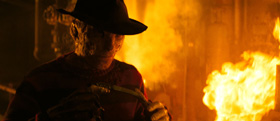 HOLLYWOOD, Calif. — A Nightmare on Elm Street is a reinvention of the seminal 1984 horror classic that unleashed Freddy Krueger upon the nightmares of a generation of fans. Now, a new Freddy Krueger, embodied by Oscar nominee Jackie Earle Haley, is born.
HOLLYWOOD, Calif. — A Nightmare on Elm Street is a reinvention of the seminal 1984 horror classic that unleashed Freddy Krueger upon the nightmares of a generation of fans. Now, a new Freddy Krueger, embodied by Oscar nominee Jackie Earle Haley, is born.
"Freddy Krueger is the mythical boogeyman," says Haley, who breathes new life into Freddy Krueger. "He’s everyone’s worst nightmare… the character in the campfire story."
"Real horror, when you think about it, relates to things on a very human level," notes Samuel Bayer, the acclaimed commercial and music video director who makes his feature film debut with A Nightmare on Elm Street. "And we all dream; it’s universal."
"To me, the most terrifying aspect of Freddy Krueger is that he comes to kill you in your sleep, when you’re at your most defenseless," says producer Michael Bay. "In your dreams, there’s nowhere to hide. You can’t escape, and he won’t stop until you either die or wake up. He provokes fears we all have."
Producer Brad Fuller attests, "In watching horror movies, you often wonder how people can put themselves in such dangerous situation, but the thing with A Nightmare on Elm Street is that no one can stay awake forever."
"Freddy’s got nothing but time," adds producer Andrew Form. "All he has to do is wait, and eventually you’ll end up in his world."
Wes Craven wrote the original A Nightmare on Elm Street after he became inspired by a series of newspaper articles about children who had suffered through a war and died from the power of their recurring nightmares. Released in 1984, the initial low-budget film, which starred Robert Englund as Freddy, became an international sensation for New Line Cinema—affectionately called "The House That Freddy Built"—and spawned a number of sequels.
Now, more than two decades later, Bay, Form and Fuller, whose Platinum Dunes production company has created a niche for reimagining classic horror properties, felt the time was right to unleash Freddy on a new generation of fans. "Growing up, I always felt that if I died in my dreams I would actually die, and that didn’t come from hearing it on the news; that came from seeing the A Nightmare on Elm Street movies," Form says. "They scared the hell out of me as a child."
Director Samuel Bayer has proven his ability to blur the lines between the real and the unreal and in him the producers saw the ideal sensibility for creating the ultimate nightmare. Form asserts, "Sam has created some of the most enduring images in his video and commercial work, and we were excited to pair him with this story."
Screenwriters Wesley Strick and Eric Heisserer used Craven’s 1984 film as a blueprint but evolved the ideas further as they explored the psychologically resonant elements of the character of Freddy Krueger. "Trying to write Freddy in a fresh way led me back to the Pied Piper, who’d punished a town by taking away its children," says Strick. "When I learned the term ‘pied’ meant ‘stripes of contrasting colors,’ just like Freddy’s famous sweater, it felt like a sign that I was on the right track—making Krueger even scarier by painting him as a righteous avenger, a dimensional villain who’s complex and more human and who may have been falsely accused."
Freddy’s home turf—where he is in total control—is the world of sleep and dreams. Bayer offers, "Through the centuries, people have tried to figure out their own psyches and why they dream, and why some people fear sleep. At some time in life, we’ve all tried to stay awake for something. We know what it feels like when you get tired and your eyes just can’t stay open. Usually it just means you fall asleep, but in this movie, you could actually die."
Heisserer found that research into this phenomenon uncovered an inescapable fact about sleep: after enough days without it, the brain shuts down to automatically recharge. Even as the teens of Elm Street resort to questionable methods in order to stay awake—from chugging energy drinks to downing prescription psychostimulants—without their knowledge they slip into a micro-sleep state.
"Micro-sleep causes you to fall asleep even for a few moments at a time," Heisserer explains. "Even though you’re still conscious and awake, part of your brain is asleep. So, that phenomenon allows Freddy to get at the characters in the story even when they’re awake…no matter where they are."
An ensemble of young actors play the teenagers now taking on Freddy Krueger, led by Rooney Mara as Nancy, Kyle Gallner as Quentin, Katie Cassidy as Kris, Thomas Dekker as Jesse, and Kellan Lutz as Dean.
The parents of the Elm Street kids are played by Clancy Brown, Connie Britton, and Lia D. Mortensen.